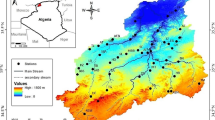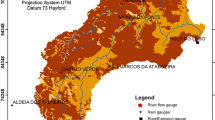Abstract
This study investigates long-term trends in annual and seasonal precipitation at 16 stations in the upper Blue Nile River basin. The non-parametric Mann–Kendall test modified by effective sample size is used to detect linear trends in the precipitation time series. The trends magnitudes and starting time of significant trends are determined using the Sen’s slope approach and the sequential Mann–Kendall test, respectively. Albeit annual precipitation shows a tendency to decrease in more than 80 % of the stations, statistically significant trends are found at only two stations. The significant decreasing trends of −40.3 and −168.1 mm/year per decade in annual precipitation at Debre Brihan and Gore stations started in the late 1970s and early 1980s respectively, which is consistent with the devastating droughts and famine during that period in the region. Owing to the great contribution of the main rainy season’s (June to September: JJAS) precipitation to annual precipitation in the upper Blue Nile basin, the variation pattern of the JJAS precipitation is very similar to that of annual precipitation. Insignificant decreasing/increasing trends in the short rainy season’s (March to May: MAM) precipitation are clearly predominant in the basin, where only one significant decreasing trend is detected in the time series.











Similar content being viewed by others
References
Bayley GV, Hammersley JM (1946) The “effective” number of independent observations in an autocorrelated time series. J R Stat Soc 8:184–197
Becker S, Gemmer M, Jiang T (2006) Spatiotemporal analysis of precipitation trends in the Yangtze River catchment. Stoch Environ Res Risk Assess 20:435–444
Bekele F (2000) Ethiopian Use of ENSO Information in its Seasonal Forecasts. National Meteorological Services Agency, Addis Ababa
Bewket W, Conway D (2007) A note on the temporal and spatial variability of rainfall in the drought-prone Amhara region of Ethiopia. Int J Climatol 27:1467–1477
Cheung WH, Senay B, Singh A (2008) Trends and spatial distribution of annual and seasonal rainfall in Ethiopia. Int J Climatol 28:1723–1734
Conway D (2000) Some aspects of climate variability in the north east Ethiopian Highlands-Wollo and Tigray. SINET Ethiop J Sci 23:139–161
Davis JC (1986) Statistics and data analysis in geology, 1st edn. Wiley, New York
Degefu W (1987) Some aspects of meteorological drought in Ethiopia. In: Glantz MH (ed) Drought and hunger in Africa. Denying famine a future. Press Syndicate of the University of Cambridge, Cambridge, pp 23–36
Du J, Fang J, Xu W, Shi P (2013) Analysis of dry/wet conditions using the standardized precipitation index and its potential usefulness for drought/flood monitoring in Hunan Province, China. Stoch Environ Res Risk Assess 27:377–387
Gissila T, Black E, Grimes D, Slingo J (2004) Seasonal forecasting of the Ethiopian summer rains. Int J Climatol 24:1345–1358
Gocic M, Trajkovic S (2014) Analysis of trends in reference evapotranspiration data in a humid climate. Hydrol Sci J 59:165–180
Golian S, Mazdiyasni O, AghaKouchak A (2014) Trends in meteorological and agricultural droughts in Iran. Theor Appl Climatol. doi:10.1007/s00704-014-1139-6
Hamed KH (2009) Enhancing the effectiveness of prewhitening in trend analysis of hydrologic data. J Hydrol 368(1–4):143–155
Hosseinzadeh Talaee P, Tabari H, Abghari H (2014) Pan evaporation and reference evapotranspiration trends detection in western Iran with consideration of data persistence. Hydrol Res 45:213–225
Huang J, Sun S, Xue Y, Li J, Zhang J (2014) Spatial and temporal variability of precipitation and dryness/wetness during 1961–2008 in Sichuan Province, West China. Water Resour Manage 28:1655–1670
IPCC (2014) In: Barros VR, Field CB, Dokken DJ, Mastrandrea MD, Mach KJ, Bilir TE, Chatterjee M, Ebi KL, Estrada YO, Genova RC, Girma B, Kissel ES, Levy AN, MacCracken S, Mastrandrea PR, White LL (eds) Climate change 2014: impacts, adaptation, and vulnerability. Part B: regional aspects. Contribution of Working Group II to the Fifth Assessment Report of the Intergovernmental Panel on Climate Change. Cambridge University Press, Cambridge
Jones JR, Schwartz JS, Ellis KN, Hathaway JM, Jawdy CM (2015) Temporal variability of precipitation in the Upper Tennessee Valley. J Hydrol Reg Stud 3:125–138
Khaliq MN, Ouarda TBMJ, Gachon P, Sushama L, St-Hilaire A (2009) Identification of hydrological trends in the presence of serial and cross correlations: a review of selected methods and their application to annual flow regimes of Canadian rivers. J Hydrol 368(1–4):117–130
Marofi S, Sohrabi MM, Mohammadi K, Sabziparvar AA, Zare Abyaneh H (2011) Investigation of meteorological extreme events over coastal regions of Iran. Theor Appl Climatol 103:401–412
McSweeney C, New M, Lizcano G (2008) UNDP climate change country profiles: Ethiopia. http://ncsp.undp.org/document/undp-climate-change-country-profile-8
Mengistu D, Bewket W, Lal R (2014) Recent spatiotemporal temperature and rainfall variability and trends over the upper Blue Nile River basin, Ethiopia. Int J Climatol 34:2278–2292
Mersha E (1999) Annual rainfall and potential evapotranspiration in Ethiopia. Ethiop J Nat Resour 1:137–154
Mersha E (2003) Assessment of moisture availability over semi-arid and arid zones of Ethiopia. Ethiop J Nat Resour 5:165–191
Meze-Hausken E (2004) Contrasting climate variability and meteorological drought with perceived drought and climate change in northern Ethiopia. Climate Res 27:19–31
Partal T, Kahya E (2006) Trend analysis in Turkish precipitation data. Hydrol Process 20:2011–2026
Rosell S (2011) Regional perspective on rainfall change and variability in the central highlands of Ethiopia, 1978–2007. Appl Geogr 31:329–338
Santos M, Fragoso M (2013) Precipitation variability in Northern Portugal: data homogeneity assessment and trends in extreme precipitation indices. Atmos Res 131:34–45
Seleshi Y, Camberlin P (2006) Recent changes in dry spell and extreme rainfall events in Ethiopia. Theor Appl Climatol 83:181–191
Seleshi Y, Zanke U (2004) Recent changes in rainfall and rainy days in Ethiopia. Int J Climatol 24:973–983
Sen PK (1968) Estimates of the regression coefficient based on Kendall’s tau. J Am Stat Assoc 63:1379–1389
Shang H, Yan J, Gebremichael M, Ayalew SM (2011) Trend analysis of extreme precipitation in the Northwestern Highlands of Ethiopia with a case study of Debre Markos. Hydrol Earth Syst Sci 15:1937–1944
Shifteh Some’e B, Ezani A, Tabari H (2012) Spatiotemporal trends and change point of precipitation in Iran. Atmos Res 113:1–12
Sneyers R (1990) On the statistical analysis of series of observations. Technical Note 143, World Meteorological Organization, Geneve
Sonali P, Nagesh Kumar D (2013) Review of trend detection methods and their application to detect temperature changes in India. J Hydrol 476:212–227
Tabari H, Hosseinzadeh Talaee P (2011) Temporal variability of precipitation over Iran: 1966–2005. J Hydrol 396:313–320
Tabari H, Shifteh Somee B, Rezaeian Zadeh M (2011) Testing for long-term trends in climatic variables in Iran. Atmos Res 100:132–140
Tabari H, Abghani H, Hosseinzadeh Talaee P (2012a) Temporal trends and spatial characteristics of drought and rainfall in arid and semi-arid regions of Iran. Hydrol Process 26:3351–3361
Tabari H, Nikbakht J, Hosseinzadeh Talaee P (2012b) Identification of trend in reference evapotranspiration series with serial dependence in Iran. Water Resour Manage 26:2219–2232
Taye MT, Willems P (2011) Influence of climate variability on representative QDF predictions of the upper Blue Nile Basin. J Hydrol 411:355–365
Taye MT, Willems P (2012) Temporal variability of hydroclimatic extremes in the Blue Nile basin. Water Resour Res 48:1–14
Taye MT, Willems P (2013) Identifying sources of temporal variability in hydrological extremes of the upper Blue Nile basin. J Hydrol 499:61–70
Tekleab S, Mohamed Y, Uhlenbrook S (2013) Hydro-climatic trends in the Abay/upper Blue Nile basin, Ethiopia. Phys Chem Earth, Parts A/B/C 61–62:32–42
Tesemma ZK, Mohamed YA, Steenhuis TS (2010) Trends in rainfall and runoff in the Blue Nile Basin: 1964–2003. Hydrol Process 24:3747–3758
Viste E, Korecha D, Sorteberg A (2013) Recent drought and precipitation tendencies in Ethiopia. Theor Appl Climatol 112:535–551
von Storch H (1995) Misuses of statistical analysis in climate research. In: von Storch H, Navarra A (eds) Analysis of climate variability: applications of statistical techniques. Springer, Berlin, pp 11–26
World Bank (2006) Ethiopia—managing water resources to maximize sustainable growth. World Bank, Washington, p 119
Yue S, Wang CY (2002) Regional streamflow trend detection with consideration of both temporal and spatial correlation. Int J Climatol 22:933–946
Yue S, Wang C (2004) The Mann–Kendall test modified by effective sample size to detect trend in serially correlated hydrological series. Water Resour Manage 18:201–218
Yue S, Pilon P, Phinney R, Cavadias G (2002) The influence of autocorrelation on the ability to detect trend in hydrological series. Hydrol Process 16:1807–1829
Zhang Q, Xu CY, Tao H, Jiang T, Chen YD (2010) Climate changes and their impacts on water resources in the arid regions: a case study of the Tarim River basin, China. Stoch Environ Res Risk Assess 24:349–358
Zhang Q, Singh VP, Sun P, Chen X, Zhang Z, Li J (2011) Precipitation and streamflow changes in China: changing patterns, causes and implications. J Hydrol 410:204–216
Zhang Z, Xu CY, El-Tahir MEH, Cao J, Singh VP (2012) Spatial and temporal variation of precipitation in Sudan and their possible causes during 1948–2005. Stoch Environ Res Risk Assess 26:429–441
Zhang A, Zheng C, Wang S, Yao Y (2015) Analysis of streamflow variations in the Heihe River Basin, northwest China: trends, abrupt changes, driving factors and ecological influences. J Hydrol Reg Stud 3:106–124
Acknowledgments
The authors would like to express their gratitude to the National Meteorology Agency in Ethiopia for providing the data. We also thank the anonymous reviewers for their useful comments and suggestions.
Author information
Authors and Affiliations
Corresponding author
Rights and permissions
About this article
Cite this article
Tabari, H., Taye, M.T. & Willems, P. Statistical assessment of precipitation trends in the upper Blue Nile River basin. Stoch Environ Res Risk Assess 29, 1751–1761 (2015). https://doi.org/10.1007/s00477-015-1046-0
Published:
Issue Date:
DOI: https://doi.org/10.1007/s00477-015-1046-0




